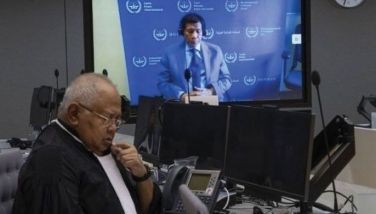Baby can you drive my car?
The car’s gleaming windshield under the night sky was the last thing I saw as I was thrown off my motorbike. My life did not flash before my eyes, I felt no pain. Was I dead? Did it happen so fast that a polished windshield was my only and last thought?
I could have been dead if the accident was real.
Game over.
As we laughed about my quasi-death on the simulator, the instructor pointed out that I made a rushed left turn – toward the wrong lane and on a blind corner.
An instant replay popped up on the screen. There I saw the seeming death wish of many motorists – except in real life it doesn’t happen in slow motion and there’s definitely no rewind button.
A whopping 83 percent of road accidents in the Philippines is caused by driver error, which could mean poor driving skills, lack of caution, traffic violation, or all of the above, according to data in a 2003 study by the Asian Development Bank (ADB).
Worldwide, the ADB says at least one million people die every year in road accidents, with 70 percent of these happening in what the World Bank classifies as “low- or middle-income” countries. The ADB projects traffic mishaps to increase by 20 percent per year by 2010 if no intervention program is initiated.
Speeding accounts for the biggest chunk of human error, closely followed by bad overtaking. Then there’s bad turning, the notorious use of mobile phones while driving, road rage and drunk driving – to complete the traffic description in Metro Manila.
Poor road condition is a valid point, since avoiding the many potholes may force the driver to swerve; but still, if he or she isn’t speeding then there would be a better chance of seeing what’s ahead on the road.
“The 10 seconds you gain for overtaking could mean the end of your life. What’s 10 seconds anyway? Let it pass,” advises Arnel Doria, general manager of the Parañaque-based Honda Safety Driving Center, where this self-confessed road maniac tried her hand at simulated motorcycle training, failing miserably 10 seconds into the exercise.
“To seriously address the accident issue, you concentrate on education of drivers and riders,” Doria says, adding that road rage is a major safety issue, especially in an overpopulated urban center like Metro Manila.
The Honda Safety Driving Center, a non-stock, non-profit foundation that opened last April, is not your typical driving school. It has basic, intermediate and skills certification driving courses – separate for car drivers and motorcyclists, including a free clinic for riders in the low-income bracket. It also has a fleet safety clinic for corporations.
Road safety is extensively discussed, not just lectured. More importantly, the driver is strongly reminded that he shares public roads with millions of other motorists and pedestrians – the key word being “public.”
“We ask our students, ‘how do you behave when another driver overtakes you?’ The normal reaction is that they feel challenged so they would try to overtake them, too. ‘What do you feel when you want to overtake but the other driver doesn’t let you? Nagagalit, hahamunin.
“Those are the things we discuss openly and we tell them what should be the proper reaction: We go back to the basic attitude of the driver – to be courteous, patient, and avoid risk-taking.”
There are 5.5 million registered motor vehicles in the Philippines – some 40 percent of these in Metro Manila – jostling for space with other road users, including pedestrians, in the city’s approximately 4,800 kilometers of road.
Many of Metro Manila’s roads “have reached their capacity,” the ADB says, thus, due to traffic congestion, the average travel speed in Metro Manila is estimated to be as low as 14 kilometers per hour.
Of the 5.5 million motor vehicles, some 1.2 million are motorcycles, including those used for public transport like tricycles. The World Health Organization last year raised the alarm on the growing number of motorcyclists, with many of them making it their “family vehicle,” just as it is now normal to see three or more riders – including children – squeezed onto a motorbike.
Motorcycles have become so popular because they are so cheap, with attractive financing schemes boosting sales.
Says Doria, “China-made motorcycles cost less than P30,000; the Japanese brand you can get at around P40,000. With a minimum wage of about P10,000, one motorcycle is approximately four months’ income.
“If you live in Biñan or San Pedro in Laguna and work in Parañaque or Taguig, when you commute you pay between P50 to P100 a day. By my last inquiry, you can get a motorcycle with a downpayment of P3,000 and a monthly of P1,500. If you’re commuting at P100 a day for one month, that’s P2,000 plus.”
The boom in motorcycle sales started as early as 2001, Doria says, when dealers initiated affordable financing schemes.
“When I was observing the market five years ago, manufacturers were selling 200,000 to 300,000 motorcycles per year. But in the last two to three years manufacturers have been expanding their factories; Yamaha is finishing its factory in Laguna, and Honda transferred from this facility in Parañaque to Batangas with a capacity of 500,000 units per year. Here, it only accommodated 200,000 units.
Add to that the unpredictable prices of fuel, and it’s easy to see why there are so many motorbikes on the road.
Marunong ka bang mag-bike?” That’s about all dealers ask their buyers.
“More often than not, when you buy a motorcycle, as long as you have the money, that’s it. They don’t ask if you have a license. They don’t ask if you have the proper riding gear. It doesn’t concern the seller,” Doria says.
Filipino drivers, whether of cars or motorbikes, rarely go to driving school; they usually have a friend or relative teach them, and this only involves operating the vehicle, without learning rules or proper behavior and courtesy.
“Based on our statistics 99 percent of the drivers we have now did not study, especially motorcycle riders,” Doria notes.
“Another major concern is that you can get your license without showing proof that you have studied,” Doria points out a basic flaw in Republic Act 4136, which he notes is outmoded. Though the law does mandate the Land Transportation Office to carry out a driver’s exam, it does not specify which and what kind of tests.
“So what happens is that some LTO offices simply ask you to drive forward, then reverse, and that’s it.”
Last year, 1.3 million student permits were issued, says Doria. “We still produce more than a million drivers who learned God knows where how to drive.”
While the LTO specifies what lessons must be covered in the curriculum of driving schools, RA 4136 is not specific about the requirements, he points out.
The law was enacted in 1964 when calesas were still around and there were fewer vehicles, Doria says. “Along the way administrative orders, etc. were issued to update it but the basic law is already very old. Someone in Congress must initiate amendments to the law to reflect the current situation.”
All this contributes to the chaos on our streets, and this is precisely where the Honda Safety Driving Center comes in.
For one thing, the center offers free lessons on motorcycle riding every Tuesday starting at 3 p.m. at its sprawling 2.4-hectare facility in East Service Road in Bicutan, Parañaque.
Private firms are taking notice of the courses they offer because, Doria says, they have become aware of the costs if the riders they employ as messengers or drivers for their fleet of company vehicles are ill trained. Among these firms are Coca-Cola, Pepsi Cola, the PNOC, pharmaceutical and agricultural companies.
Doria cites a Johnson & Johnson factory that sponsored a group of 200 tricycle drivers for free training, even subsidizing the income they would lose by attending the training.
“That’s social responsibility, as it’s common to see tricycles lined up outside factories. I hope others would follow,” he says, adding, “Another training they specially requested from us is on first-aid because these drivers are the first ones to witness road accidents.”
The Center has 19 instructors with specialized training from experts in Singapore and Japan.
They teach the “Three Es” of road safety, namely Engineering, Enforcement and Education.
For Engineering, there is nothing an average road user can do since it concerns the road networks and traffic system. The same goes for Enforcement, given that strict and consistent enforcement is practically nonexistent.
Besides, both engineering and enforcement do not constitute as much danger as education does.
Lectures and showing how a car or motorcycle works are not enough to make one an educated driver, Doria says.
“There’s a big difference between a good driver and a good road user. A good driver can operate a car skillfully but he has no concern for other road users, only himself,” he says.
A good road user knows the way he drives affects him and his surroundings.
The question is – which are you?
The Honda Safety Driving Center is on Km. 17 East Service Road, South Super Highway, Parañaque. For more inforation, call 838-0814 or visit their website www.hondasafetydriving.ph.
- Latest
- Trending



















